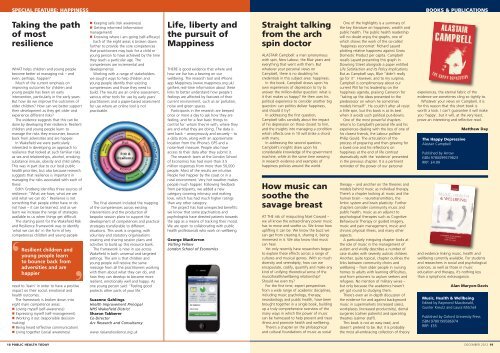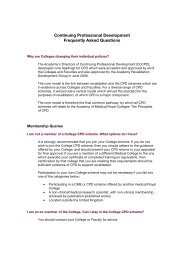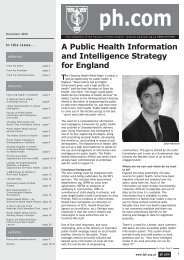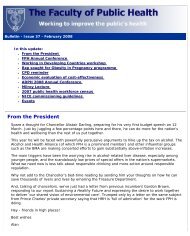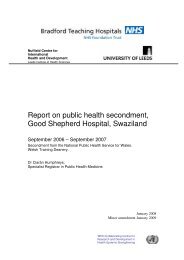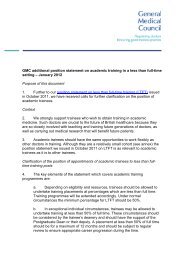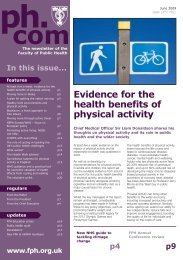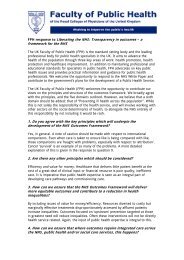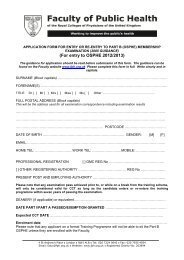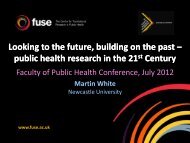SPECIAL FEATURE: HAPPINESSBOOKS & PUBLICATIONSTaking the path<strong>of</strong> mostresilienceWHAT helps children and young peoplebecome better at managing risk – andeven, perhaps, happier?Much <strong>of</strong> the current emphasis onimproving outcomes for children andyoung people has been on earlyintervention, particularly in the early years.But how do we improve the outcomes <strong>of</strong>older children? How can we better supporttheir development as they get older andexperience different risks?The evidence suggests that this can bedone by developing their resilience. Resilientchildren and young people learn tomanage the risks they encounter, bounceback from adversities and are happier.In Wakefield we were particularlyinterested in developing an approach toresilience that looked at such familiar risksas sex and relationships, alcohol, smoking,substance misuse, obesity and child safety.This was in part due to our local publichealth priorities, but also because researchsuggests that resilience is important inmanaging the risks associated with each <strong>of</strong>these.Edith Grotberg identifies three sources <strong>of</strong>resilience: “What we have, what we areand what we can do.” Resilience is notsomething that people either have or donot have – it can be learned, and as welearn we increase the range <strong>of</strong> strategiesavailable to us when things get difficult.The starting point for the Wakefield Riskand Resilience Framework was to identify‘what we can do’ in the form <strong>of</strong> keycompetences children and young peopleResilient children andyoung people learnto bounce back fromadversities and are‘happier‘need to ‘learn’ in order to have a positiveimpact on their social, emotional andhealth outcomes.The framework is broken down intoeight main competence areas:n Loving myself (self-awareness)n Expressing myself (self-management)n Working it out (responsible decisionmaking)n Being heard (effective communication)n Living together (social awareness)n Keeping safe (risk awareness)n Getting informed (informationmanagement)n Knowing where I am going (self-efficacy)Each <strong>of</strong> the eight areas is broken downfurther to provide the core competencesthat practitioners may look for a child oryoung person to have achieved by the timethey reach a particular age. Thecompetences are incremental anddevelopmental.Working with a range <strong>of</strong> stakeholderswe sought ways to help children andyoung people identify their existingcompetencies and those they need tobuild. The results are an online assessment,various other tools for use by early years’practitioners and a paper-based assessmentfor use where an online tool is notpracticable.The final element included the mapping<strong>of</strong> the competencies across existinginterventions and the production <strong>of</strong>bespoke session plans to support thedevelopment <strong>of</strong> competences and practicalstrategies transferable to differentsituations. This work is ongoing, withvoluntary and statutory organisationscreating and sharing session plans andactivities to build up this resource bank.The framework is now in use acrossWakefield in both universal and targetedsettings. The aim is that children andyoung people will receive the samemessage from all the practitioners workingwith them about what they can do, andhow they can develop to become moreresilient, emotionally well and happy. Asone young person said: “Feeling goodprotects other parts <strong>of</strong> your life.”Suzanne Gahlings<strong>Health</strong> Improvement PrincipalNHS Wakefield DistrictSharon TabbererCo-DirectorArc Research and Consultancywww.riskandresilience.org.ukLife, liberty andthe pursuit <strong>of</strong>MappinessTHERE is good evidence that where andhow we live has a bearing on ourwellbeing. The research tool and iPhoneapp Mappiness (www.mappiness.org.uk)gathers real-time information about theselinks to better understand how people'sfeelings are affected by features <strong>of</strong> theircurrent environment, such as air pollution,noise and green spaces.Participants in the research are beepedonce or more a day to ask how they arefeeling, and for a few basic things tocontrol for: whom they’re with, where theyare and what they are doing. The data issent back – anonymously and securely – toa data store, along with an approximatelocation from the iPhone’s GPS and anoise-level measure. People also haveaccess to their data after they submit it.The research team at the London School<strong>of</strong> Economics has had more than 3.5million responses from more than 50,000people. Most <strong>of</strong> the results are intuitive.People feel happier by the coast or in arural environment. Very hot weather makespeople much happier. Following feedbackfrom participants, we added a newcategory covering intimacy and makinglove, which has had much higher ratingsthan any other category.The project has had unexpected benefits:we know that some psychiatrists andpsychologists have directed patients towardsthe app as a means <strong>of</strong> tracking their mood.We are open to collaborating with publichealth pr<strong>of</strong>essionals who work on wellbeing.George MacKerronVisiting FellowLondon School <strong>of</strong> EconomicsStraight talkingfrom the archspin doctorALASTAIR Campbell: a man synonymouswith spin, New Labour, the Blair years andeverything that went with them. Butwhatever your personal views onCampbell, there is no doubting hiscredentials in this subject area: happiness.In this book, Campbell draws upon hisown experiences <strong>of</strong> depression to try toanswer the million-dollar question: what isit that makes us happy? He then uses hispolitical experience to consider another bigquestion: can politics deliver happiness,and should it try?In addressing the first question,Campbell talks candidly about the impact<strong>of</strong> his depression on those closest to him,and the insights into managing a conditionwhich affects one in 10 will strike a chordwith many.In addressing the second question,Campbell’s insights draw upon hisconsiderable knowledge <strong>of</strong> the governmentmachine, while at the same time weavingin research evidence and examples <strong>of</strong>happiness policies around the world.How music cansoothe thesavage breastAT THE risk <strong>of</strong> misquoting Noel Coward –we all know the extraordinary power musichas to move and soothe us. We know howuplifting it can be. We know the buzz wecan get from creating it, sharing it, beingimmersed in it. We also know that musiccan heal.Yet only recently have researchers begunto explore these effects across a range <strong>of</strong>cultures and musical genres. With so muchdiversity and serendipity, how can weencapsulate, codify, quantify and make anykind <strong>of</strong> unifying theoretical sense <strong>of</strong> themusic/health/wellbeing relationship?Should we even try?For the first time, expert perspectivesfrom a wide range <strong>of</strong> academic disciplines,including music psychology, therapy,neurobiology and public health, have beenbrought together in a single book, buildingup a truly comprehensive overview <strong>of</strong> themany ways in which the power <strong>of</strong> musiccan be harnessed to help prevent and treatillness and promote health and wellbeing.There’s a chapter on the philosophicaland cultural foundations <strong>of</strong> music as socialOne <strong>of</strong> the highlights is a summary <strong>of</strong>the key literature on happiness, wealth andpublic health. The public health readershipwill no doubt enjoy the graphs, one <strong>of</strong>which shows the work <strong>of</strong> the so-called‘happiness economist’ Richard Layardplotting relative happiness against GrossDomestic Product per capita. Campbellrecalls Layard presenting this graph inDowning Street alongside a paper entitledLife Satisfaction and Its Policy Implications.But as Campbell says, Blair “didn’t reallygo for it”. However, and to my surprise,Campbell is complimentary about ourcurrent PM for his leadership on thehappiness agenda, praising Cameron for“taking up the ideas presented to thepredecessor on whom he sometimesmodels himself”. He couldn’t after all resista little spin, but this book is at its bestwhen it avoids such political put-downs.One <strong>of</strong> the most powerful chaptersreturns to Campbell’s personal life and hisexperiences dealing with the loss <strong>of</strong> one <strong>of</strong>his closest friends, the Labour pollsterPhilip Gould. The articulation <strong>of</strong> theprocess <strong>of</strong> preparing and then grieving fora loved one and his reflections onhappiness at the end <strong>of</strong> life contrastdramatically with the ‘evidence’ presentedin the previous chapter. It is a pertinentreminder <strong>of</strong> the power <strong>of</strong> our personaltherapy – and another on the theories andmodels behind music as individual therapy.There’s a chapter looking at music and thehuman brain – neurotransmitters, thelimbic system and brain plasticity. Furtherchapters consider community music andpublic health, music as an adjunct topsychological therapies such as CognitiveBehavioural Therapy or guided imagery,music and pain management, music andchronic physical illness, and many otheraspects.A particularly intriguing chapter looks atthe role <strong>of</strong> music in the management <strong>of</strong>autism and vividly describes a number <strong>of</strong>case studies with severely autistic children.Another, quite topical, chapter outlines thelinks between community choirs andwellbeing – from older people in nursinghomes to adults with learning difficulties,and from prisoners to asylum seekers andrefugees. No mention <strong>of</strong> military wives –but only because the academics haven’tyet got round to studying them.There’s even an in-depth discussion <strong>of</strong>the evidence for and against backgroundmusic in supermarkets (increased sales),workplaces (increased productivity), dentalsurgeries (calmer patients) and operatingtheatres (calmer staff).This book is not an easy read, anddoesn’t pretend to be. But it is probablythe most all-embracing collection <strong>of</strong> theoryexperiences, the eternal fabric <strong>of</strong> theevidence we sometimes cling so tightly to.Whatever your views on Campbell, it isfor this reason that this short book isworth a look. I can’t guarantee it will makeyou ‘happy’, but it will, at the very least,prove an interesting and reflective read.The Happy DepressiveAlastair CampbellPublished by ArrowISBN 9780099579823RRP: £4.99Matthew Dayand evidence linking music, health andwellbeing currently available. For studentsand researchers in social and psychologicalsciences, as well as those in musiceducation and therapy, it’s nothing lessthan a symphonic extravaganza.Alan Maryon-DavisMusic, <strong>Health</strong> & WellbeingEdited by Raymond Macdonald,Gunter Kreutz and Laura MitchellPublished by Oxford University PressISBN 9780199586974RRP: £5518 PUBLIC HEALTH TODAYDECEMBER 2012 19
ENDNOTESENDNOTESA spotlight on...Rob HowardI WAS reminded a couple <strong>of</strong> weeks agothat every public health intervention is abalance between benefits and risks. Ithappened when I fell <strong>of</strong>f my bike,breaking my collarbone and a rib. No,I wasn’t trying to do a Bradley Wiggins– although our cycling careers have<strong>of</strong>ten been in strange parallel. When hewas winning the Tour de France, I waswatching it on TV.So, what are the benefits and risks <strong>of</strong>chairing the Specialty RegistrarsCommittee (SRC)? Well, the benefits areeasy. The SRC is the FPH committee(strictly a sub-committee <strong>of</strong> theEducation Committee) that representsthe interests and views <strong>of</strong> all publichealth registrars across the <strong>UK</strong>. As chair<strong>of</strong> the committee I am also a co-optedmember <strong>of</strong> the FPH Board, and attendFPH Executive meetings. This presents afantastic opportunity to learn fromhugely experienced and committedpublic health specialists from a widevariety <strong>of</strong> backgrounds. It provides anopportunity to influence the direction <strong>of</strong>public health training and to representthe interests <strong>of</strong> registrars across the <strong>UK</strong>.It also gives me great insight into some<strong>of</strong> the national discussions on the future<strong>of</strong> public health – particularlyfascinating in times <strong>of</strong> such greatchange.The risks? Well, one <strong>of</strong> the roles <strong>of</strong>the SRC is to represent registrars on aplethora <strong>of</strong> committees (at least 18) andto respond to the numerousconsultation documents that require aregistrar perspective. Fortunately, theSRC has two Deputy Chairs – SiobhanFarmer from the North West Deaneryand Ben Leaman from Yorkshire andHumber – and we divide the workloadbetween us. Each member <strong>of</strong> the SRCcommits to representing the SRC on atleast one committee, and we also havenominated leads to develop actionplans for the three priority areas we willbe working on over the following 12months:n ensuring the future <strong>of</strong> a multidisciplinaryworkforcen ensuring better linkage between theFPH work programme and the work <strong>of</strong>the SRCn ensuring suitability <strong>of</strong> traininglocations – including the promotion <strong>of</strong>registrars to local authorities.More than enough to be going onwith. Handily, the work <strong>of</strong> the SRC alsocontributes to some <strong>of</strong> the moredifficult-to-achieve learning outcomes!So, like cycling, it’s clear to me thatthe benefits far outweigh the risks, evenif at times it can be a little painful.Rob HowardChairFPH Specialty Registrars CommitteeLettersI thought you made a good job <strong>of</strong> the<strong>Public</strong> <strong>Health</strong> Today issue on men’s health.I can see a fair bit <strong>of</strong> effort went in topreparing it. I was intrigued to note howmany <strong>of</strong> the contributions were written bywomen. This I guess is in keeping with thefact that, in general, men do not takemuch interest in their own health.It was a relief to see that men’s healthissues were recognised as going wellbeyond the usual focus on testicular cancerand prostate cancer which, <strong>of</strong> course,make up only a small part <strong>of</strong> the picture.I was, however, concerned to read thecomment by Alan Maryon-Davis whoreferred to “the challenge <strong>of</strong> engagingmen in testicular self examination”. Thereis, in fact, not a shred <strong>of</strong> evidence thatritualistic testicular self examination isbeneficial, and it may well be harmful bycausing anxiety (the ‘worried well’syndrome) and by the identification <strong>of</strong>minor abnormalities (or variations fromnormal) which waste health service timeand effort.The same issues have, <strong>of</strong> course, arisenin relation to ritualistic breast selfexamination which is not encouragedby the national screening programme.Rather, we have the concept <strong>of</strong> ‘breastawareness’ which was first put forwardand developed by the late Dr JoanAustoker. This concept encourages womento be aware <strong>of</strong> what is normal for theirbreasts when bathing, showering etc butwithout going through some regularritualistic anxiety-provoking procedure.By the same token, men should beencouraged to develop ‘testicularawareness’ rather than followingritualistic self examination.Martin VesseyEmeritus Pr<strong>of</strong>essor <strong>of</strong> <strong>Public</strong> <strong>Health</strong>Oxford UniversityEvery year, people get hot under the collarabout the few per cent (6.4% this year)fewer boys who get A*-C GCSEs. DebbieWeekes-Bernard did so in the Sept 2012issue <strong>of</strong> <strong>Public</strong> <strong>Health</strong> Today. I’m notsurprised by journalists and politiciansdoing this, but I do find it surprising thatpublic health pr<strong>of</strong>essionals (or peoplewriting for them) make this point and missthe far more important one.Thirty-nine per cent <strong>of</strong> girls and 45.4%<strong>of</strong> boys do not achieve this level <strong>of</strong>educational qualification. While it will neverbe 100% who are able to achieve this,should we not be focusing on the largeproportion <strong>of</strong> boys and girls whoshould/could but do not, rather than onthe relatively small difference between girlsand boys?Jennifer MindellClinical senior lecturer<strong>Health</strong> and Social Surveys ResearchGroupResearch Department <strong>of</strong> Epidemiologyand <strong>Public</strong> <strong>Health</strong>University College LondonInternationalcommitteeupdateTHERE are many ‘international’ activities inwhich FPH could be involved and whichwould draw on the extensive public healthknowledge and skill that we have in the<strong>UK</strong>. But, because <strong>of</strong> limited resources, weneed to be clear about which activitiesrelate to the core work <strong>of</strong> FPH and onwhich it should lead, and which might bebetter led by others, supported by FPH.Over the past six months, the InternationalCommittee (IC) has considered the uniquerole <strong>of</strong> FPH and identified two key areas <strong>of</strong>work: supporting FPH overseas membersand contributing to standards through thedevelopment <strong>of</strong> competencies and training.Current initiatives include:n FPH International Network Group – theING is being reinvigorated to form avibrant community for discussion andinformation-sharing on international publichealth issues and for disseminatinginformation on job opportunities, trainingplacements, projects etc. The group is opento all FPH members and will provide avaluable forum for the development <strong>of</strong>links and for closer engagement with thework <strong>of</strong> the IC. If you are not already amember, you can sign up athttp://new.fph-groups.org.uk/.n Global health in the public healthcurriculum – the IC will be working withthe Education Committee on the curriculumreview. It is keen to see a small number <strong>of</strong>core learning outcomes in global healthincluded within the curriculum.n Sudan and South Sudan – FPH hasmemoranda <strong>of</strong> understanding (MOU) withSudan and the Ministry <strong>of</strong> <strong>Health</strong> in SouthSudan. It will be working with bothcountries on the development <strong>of</strong> trainingand standards.n West African College <strong>of</strong> Physicians –discussions are ongoing with WACP onpossible further work.n Development <strong>of</strong> standards – the IC is toundertake a review <strong>of</strong> other countries withwhich FPH might engage in the future onthe development <strong>of</strong> standards. There iscurrently widespread debate across Asia ontraining in public health, which mightprovide an opportunity for FPH engagementin the region. The IC has recently receiveddirect approaches from the Chapter <strong>of</strong><strong>Public</strong> <strong>Health</strong> and Occupational MedicinePhysicians, Academy <strong>of</strong> Medicine,Singapore (with which an MOU isproposed), the <strong>Public</strong> <strong>Health</strong> Africa Groupand the Malawi <strong>Public</strong> <strong>Health</strong> Forum.Potential areas <strong>of</strong> collaboration are to beexplored. The IC will also be looking tosupport workforce initiatives in Europe.n Partnership working - the IC is keen toengage in partnership working. It is amember <strong>of</strong> the International Forum <strong>of</strong> the<strong>UK</strong> Academy <strong>of</strong> Medical Royal Collegesand the European <strong>Public</strong> <strong>Health</strong> Association.It also has close links with the <strong>UK</strong> <strong>Health</strong>Protection Agency and the <strong>UK</strong> Departmentfor International Development, both <strong>of</strong>which are represented on the committee.Finally, and most importantly, the IC iskeen to engage with FPH members and toharness the extensive experience andinterest that members have in global publichealth. We would welcome yourinvolvement through the InternationalNetwork Group or you can contact thecommittee directly via Lauren Ince(laureni@fph.org.uk), secretary to the IC.Pat TroopChairFPH International CommitteeIn memoriamDavid Morrell FFPH1929 – 2012PROFESSOR David Morrell, who died inMarch, was a pioneer <strong>of</strong> modern generalpractice training and the first academic GPto become President <strong>of</strong> the BMA.In 1962, after five years as a GP inHertfordshire, Morrell joined the world’sfirst university department <strong>of</strong> generalpractice, based in modest premises in WestRichmond Street, Edinburgh, combiningnormal clinical work on the ground floorwith teaching and research upstairs. Fiveyears later he transferred this model toKennington, south London, as adepartment <strong>of</strong> St Thomas’s HospitalMedical School, becoming WolfsonPr<strong>of</strong>essor in 1974.He developed a close relationship withthe Department <strong>of</strong> <strong>Public</strong> <strong>Health</strong> Medicine,and his team were greatly aided by soundadvice on epidemiology, statistics andresearch methodology. His particularinterest was in factors influencing demandfor primary care and the ways in whichpatients responded to minor illnesses.David Morrell pioneered theundergraduate teaching <strong>of</strong> general practicewith experiential modules involving a livelymix <strong>of</strong> seminars, practice consultations andhome visits. He set up London’s firstvocational training scheme in generalpractice and co-founded the world’s firstMasters’ course in primary care. He wasawarded the OBE in 1982 and becameBMA President on his ‘retirement’ in 1994.Peter Ambrose1933 – 2012PROFESSOR Peter Ambrose, a radicalacademic who pioneered social housingand campaigned tirelessly against cuts inhousing benefits, died in August at the age<strong>of</strong> 79.Born in south-east London, he leftschool at 16, working as a bank clerkbefore doing National Service in RAFCoastal Command. He then enteredacademia: at Kings College London, McGillUniversity Montreal and, in 1965, alectureship in geography at the University<strong>of</strong> Sussex. His great interest was urbanstudies, particularly the interplay <strong>of</strong> land,property, housing and finance on socialjustice and inequalities. In 1974 hisinspirational book The Quiet Revolutiongained him widespread recognition as aradical thinker and activist whose mainfocus was on real people in real places.Peter Ambrose retired from Sussex in1998, but was quickly appointed visitingpr<strong>of</strong>essor <strong>of</strong> housing studies at BrightonUniversity and advisor to the Zacchaeus2000 Trust. His most recent researchlooked at the links between poor housingand poor health, and the impact <strong>of</strong> highhousing costs on poverty and debt. Suchwas his dedication and commitment that,despite being laid low with cancer, hefinished drafting the Pro-Housing Alliancesubmission to the ParliamentaryCommission on Banking Standards justdays before he died.DeceasedmembersThe following members havealso passed away:Dr William Lawrence FFPHDr Jeanette Morrison FFPHDr John Power FFPHPr<strong>of</strong>essor William Ross FFPH20 PUBLIC HEALTH TODAYDECEMBER 2012 21


